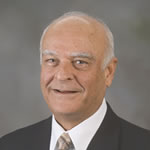
Leonardo da Vinci observed that "motion is the cause of all life." For Ali Nayfeh, that is because life is about change, and change is about complexity, or more accurately, what scientists call nonlinearity—when simple causes can result in complicated and sometimes unexpected effects. All dynamic systems, anything that moves and changes over time, are by definition nonlinear, and that makes analyzing them, understanding them, and predicting their behavior a challenge. To understand nonlinear systems, we need to develop models: models of how ships move on rough seas; how cranes lifting steel beams react to unexpected mechanical vibrations or to their loads shifting or spinning; the stresses experienced by aircraft at high speeds and spacecraft hurtling back to Earth through the friction of the atmosphere. These, and the myriad of similar phenomena are questions both of theoretical physics and mathematics, and of practical engineering. During the past several decades, perhaps no one has contributed more to our understanding of nonlinear dynamics than Nayfeh. Though grounded in elegant and complex mathematics, his work is far more than merely theoretical. Its applications encompass devices, structures, and systems that we all encounter and depend upon on a daily basis.
Nayfeh entered Stanford University as a freshman in 1959 and extraordinarily graduated with a Ph.D. in aeronautics and astronautics engineering less than five years later. He immediately began working in America's burgeoning aerospace industry, first at Heliodyne until 1968, then at the Aerotherm Corporation until 1971. Nayfeh then shifted his focus from the industrial world to the academic realm, becoming a professor at Virginia Tech and also founding dean of the engineering school at Yarmouk University in Jordan.
In a broad sense, Nayfeh's specialty is about finding some kind of order and predictability in the midst of seeming chaos, whether in the form of the vibrations and sound occurring in jet and rocket engines, the movement of water around ships, or the oscillations of huge structures such as cranes and skyscrapers. These are all dynamic nonlinear systems that constantly generate changes within and without, and when those changes involve vibrations that overstress a structure or conflict with others, dangerous consequences may result. A bridge may collapse; a ship may break apart; a building may fall; a plane may crash. Nayfeh developed new analytical methods for the solution of the nonlinear ordinary and partial differential equations that are at the heart of these phenomena. By originating the use of multiple time scales in perturbation analysis, he went even further, revolutionizing the use of these techniques for practical design. His two books on perturbation are standard texts in the field, notwithstanding the influence of his nine other books and nearly 500 research articles.
At Virginia Tech, Nayfeh established a nonlinear dynamics laboratory where he and his graduate students can actually test and observe the physical realities modeled by the symbols in his equations. This fusion of theory and experiment has led to practical innovations, such as ways to stabilize the dangerous pendulum oscillations that can arise in crane payloads aboard ships at sea.
Now University Distinguished Professor Emeritus at Virginia Tech and University Distinguished Professor at the University of Jordan, Nayfeh is recognized worldwide as a leading authority on nonlinear systems of all types, from the very large and noisy (rockets and missiles, aircraft, cranes, ships) to the very small and silent (computer software, microelectromechanical systems, nanotechnology). The impact of his work and the analysis techniques he has developed ranges far beyond mechanical engineering into physics and mathematics. The generation of students that Nayfeh trained and mentored will ensure that his influence, both as a theoretician and as an experimentalist, will endure.
Information as of April 2014

